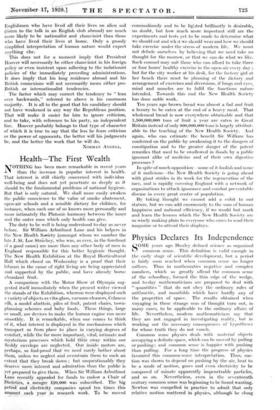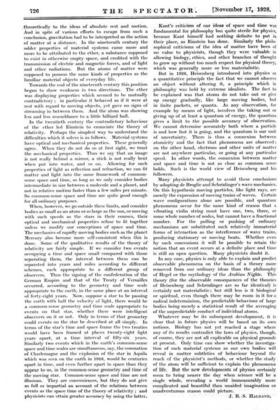Physics Declares Its Independence
SOME years ago Huxley defined science as organized common sense. This definition is valid enough in the early stage of scientific development, but a period is fairly soon reached when common sense no longer suffices. Thus in mathematics negative and complex numbers, which so greatly offend the common sense of the schoolboy, formed the thin edge of the wedge, and to-day mathematicians arc prepared to deal with " quantities " that do not obey the ordinary rules of arithmetic, and manifolds which have hardly any of the properties of space. The results obtained when voyaging in these strange seas of thought turn out, in many cases, to be applicable to the ordinary affairs of life. Nevertheless, modern mathematicians say that they are not engaged in investigating reality, but in working out the necessary consequences of hypotheses for whose truth they do not vouch. Common sense physics deals with material objects occupying a definite space, which can be moved by pulling or pushing; and common sense is happier with pushing than pulling. For a long time the progress of physics favoured this common-sense interpretation. Thus, suc- tion was shown to depend on pushing by the air, heat to be a mode of motion, gases and even electricity to be composed of minute apparently impenetrable particles, and so on. Nevertheless, even in the seventeenth • • century common sense was beginning to bifound, wanting, Newton was compelled in practice to admit that only relative motion mattered in physics; although he clung theoretically to the ideas of absolute rest and motion. And in spite of various efforts to escape from such a conclusion, gravitation had to be interpreted as the action of matter at a distance. In the nineteenth century the odder properties of material systems came more and more to be attributed to the ether, a substance supposed to exist in otherwise empty space, and credited with the transmission of electric and magnetic forces, and of light and other radiations. But the atoms of matter were supposed to possess the same kinds of properties as the familiar material objects of everyday life.
Towards the end of the nineteenth century this position began to show weakness in two directions. The ether was displaying properties which seemed to be mutually contradictory ; in particular it behaved as if it were at rest with regard to moving objects, yet gave no Signs of streaming in between them. And the atom was showing less and less resemblance to a little billiard ball.
In the twentieth century the contradictory behaviour of the ether led Einstein to enunciate the theory of relativity. Perhaps the simplest way to understand the difficulties which it solves is as follows. Material systems have optical and mechanical properties. These generally agree. When they do not do so at first sight, we trust the mechanical properties. Thus we say that an image is not really behind a mirror, a stick is not really bent when put into water, and so on. Allowing for such properties of light as reflection and refraction, we can fit matter and light into the same framework of common- sense space and time, so long as we only consider bodies intermediate in size between a molecule and a planet, and not in relative motion faster than a few miles per minute. So common-sense space and time arc quite good enough for all ordinary purposes.
When, however, we go outside these limits, and consider bodies as small as an atom or as large as the sun, or moving with such speeds as the stars in their courses, their optical and mechanical properties refuse to fit together unless we modify our conceptions of space and time. The mechanics of rapidly moving bodies such as the planet Mercury also become more self-consistent when this is done. Some of the qualitative results of the theory of relativity are fairly simple. If we consider two events occupying a time and space small compared with those separating them, the interval between them can be separated into years and miles according to different schemes, each appropriate to a different group of observers. Thus the signing of the confederation of the German Empire and that of the Treaty of Versailles occurred, according to the geometry and time scale appropriate to the earth, in the same place at an interval of forty-eight years. Now, suppose a star to be passing the earth with half the velocity of light, there would be a common-sense geometry and time scale appropriate to events on that star, whether there were intelligent observers on it or not. Only in terms of that geometry could events on the star be described at all simply. In terms of the star's time and space frame the two treaties would have been framed at places twenty-eight light years apart, at a time interval of fifty-six years. Similarly two events which in the earth's common-sense space and time scales are simultaneous, say, the coronation of Charlemagne and the explosion of the star in Aquila which was seen on the earth in 1918, would be centuries apart in time, and even further apart in space than they appear to us, in the common-sense geometry and time of the moving star. Common-sense space and time are not illusions. They are conveniences, but they do not give as full or impartial an account of the relations between events as the space time of the theory of relativity ; and physicists can attain greater accuracy by using the latter. Kant's criticism of our ideas of space and time was fundamental for philosophy but quite sterile for physics, because Kant himself had nothing definite to put in their place, as Einstein has done. Similarly the phile; sophical criticisms of the idea of matter have been of no value to physicists, though they were valuable in allowing biology, ethics, and other branches of thought to grow up without too much respect for physical theory, which was generally more or less materialistic.
But in 1926, Heisenberg introduced into physics as a quantitative principle the fact that we cannot observe an object without altering it, a principle which in philosophy was held by extreme idealists. The fact to be explained was that atoms do not take out or give up energy gradually, like large moving bodies, but in finite packets, or quanta. As any observation, for example by means of light, involves the taking out or giving up of at least a quantum of energy, the quantum gives a limit to the possible accuracy of observation. We cannot determine accurately both where a particle is and how fast it is going, and the quantum is our unit of uncertainty. There is thus a connexion between atomicity and the fact that phenomena are observed ; on the other hand, electrons and other units of matter are not anywhere particular, or going at any particular speed. In other words, the connexion between matter and space and time is not as close as common sense holds. Such is the world view of Heisenberg and his followers.
Many physicists attempt to avoid these conclusions by adopting de Broglie and Schrodinger's wave mechanics. On this hypothesis moving particles, like light rays, are merely the expression of moving trains of waves. Certain wave configurations alone are possible, and quantum phenomena occur for the same kind of reason that a vibrating violin string must have one, two, three, or some whole number of nodes, but cannot have a fractional number. For the pulling or pushing of ordinary mechanisms are substituted such relatively immaterial forms of interaction as the interference of wave trains, producing stationary or moving beats. Whether even by such concessions it will be possible to retain the notion that an event occurs at a definite place and time is still an open question. Many physicists doubt it.
In any case, physics is only able to explain and predict observable phenomena on the basis of a theory more removed from our ordinary ideas than the philosophy of Hegel or the mythology of the Arabian Nights. This theory (for the observable consequences of the theories of Heisenberg and Schrodinger are so far identical) is certainly not materialistic; but still less is it biological or spiritual, even though there may be room in it for a radical indeterminism, the predictable behaviour of large bodies being merely a statistical result of the averaging of the unpredictable conduct of individual atoms.
Whatever may be its subsequent development, it is clear that in future physics will be based on its own notions. Biology has not yet reached a stage where any of its results contradict the laws of physics, though, of course, they are not all explicable on physical grounds at present. Only time can show whether the investiga- tion of such material systems as our own bodies will reveal in matter subtleties of behaviour beyond the reach of the physicist's methods, or whether the study of the atom will be sufficient to explain the phenomena of life. But the new developments of physics certainly seem to bring nearer the day when science will be a single whole, revealing a world immeasurably more complicated and beautiful than unaided imagination or unadventurous reason could picture.
J. B. •S. 11-u.DANE.







































 Previous page
Previous page